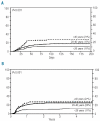Impact of age on outcomes after bone marrow transplantation for acquired aplastic anemia using HLA-matched sibling donors
- PMID: 20851870
- PMCID: PMC2995571
- DOI: 10.3324/haematol.2010.026682
Impact of age on outcomes after bone marrow transplantation for acquired aplastic anemia using HLA-matched sibling donors
Abstract
Background: Transplantation from an HLA-matched sibling is the treatment of choice for young patients with acquired severe aplastic anemia. For older patients, the acceptable upper age limit for transplantation as first-line treatment varies. The current analysis, therefore, sought to identify age or ages at transplantation at which survival differed.
Design and methods: We studied the effect of patients' age, adjusting for other significant factors affecting outcomes, in 1307 patients with severe aplastic anemia after HLA-matched sibling transplantation using logistic and Cox regression analysis. Age categories (<20 years, 20-40 years, >40 years) were determined using Martingale residual plots for overall survival and categories based on differences in survival.
Results: Patients aged over 40 years old were more likely to have had immunosuppressive therapy, a poor performance score and a longer interval between diagnosis and transplantation. Neutrophil recovery was similar in all age groups but patients aged over 40 years had a lower likelihood of platelet recovery compared to patients aged less than 20 years (OR 0.45, P=0.01) but not compared to those aged 20-40 years (OR 0.60, P=0.10). Compared to the risk of mortality in patients aged less than 20 years, mortality risks were higher in patients over 40 years old (RR 2.70, P<0.0001) and in those aged 20-40 years (RR 1.69, P<0.0001). The mortality risk was also higher in patients aged over 40 years than in those 20-40 years old (RR 1.60, P=0.008).
Conclusions: Mortality risks increased with age. Risks were also higher in patients with a poor performance score and when the interval between diagnosis and transplantation was longer than 3 months, implying earlier referral would be appropriate when this treatment option is being considered.
Figures
References
-
- Marsh JC, Ball SE, Cavenagh J, Darbyshire P, Dokal I, Gordon-Smith EC, et al. Guidelines for the diagnosis and management of aplastic anaemia. Br J Haematol. 2009;147(1):43–70. - PubMed
-
- Doney K, Leisenring W, Storb R, Appelbaum FR. Primary treatment of acquired aplastic anemia: outcomes with bone marrow transplantation and immuno-suppressive therapy. Seattle Bone Marrow Transplant Team. Ann Intern Med. 1997;126(2):107–15. - PubMed
-
- Gupta V, Marsh J. Acquired aplastic anemia and Fanconi anemia. In: Barrett J, Trealeaven J, editors. Practical Stem Cell Transplantation. 2009. pp. 165–77.
Publication types
MeSH terms
Grants and funding
LinkOut - more resources
Full Text Sources
Medical
Research Materials



